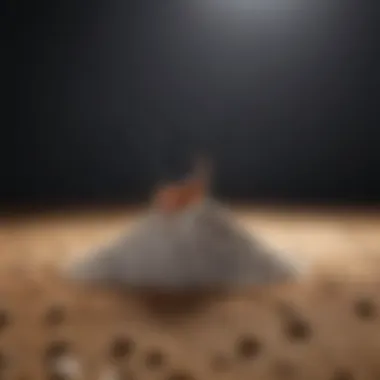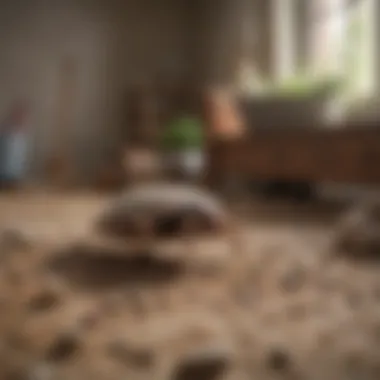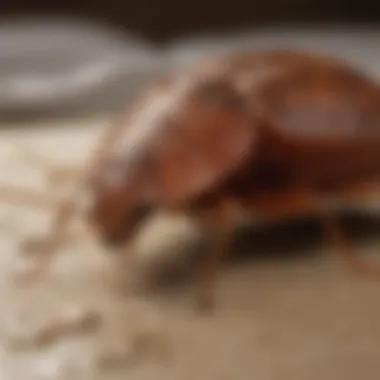Top Diatomaceous Earth Solutions for Bed Bug Control


Intro
Diatomaceous earth is a natural substance that has become prominent in pest control, especially against bed bugs. Understanding what diatomaceous earth is and how it works may benefit homeowners and professionals alike who are looking for effective and eco-friendly solutions. This article will discussion several aspects of diatomaceous earth, providing a comprehensive overview of its relevance in the management of bed bug infestations.
Armed with the knowledge of diatomaceous earth's properties, methods of application, and safety guidelines, readers will be better equipped to tackle these common pests. Let's delve into the key concepts and terminology related to diatomaceous earth to lay a solid foundation for understanding its role in pest control.
Understanding Diatomaceous Earth
Understanding diatomaceous earth is crucial for effectively dealing with bed bugs. It provides both homeowners and professionals with a natural alternative to chemical pest control methods. This introduction to diatomaceous earth sets the foundation for the benefits, applications, and safety considerations that will be discussed in further detail in this article. Knowing about diatomaceous earth can give readers a proper context for its role in pest management and how to use it effectively.
Definition and Composition
Diatomaceous earth, commonly abbreviated as DE, is a naturally occurring soft sedimentary rock. It consists mainly of the fossilized remains of tiny aquatic organisms called diatoms. These diatoms are rich in silica, which gives diatomaceous earth its distinctive abrasive properties. When dry, DE is powdery, and its fine particles can be spread easily across various surfaces. This combination of characteristics is what makes it effective as a pest control method, especially against bed bugs.
Origins and Source of Diatomaceous Earth
Diatomaceous earth is harvested from geological deposits formed over millions of years. These deposits can be found in many parts of the world, including the United States, China, and Germany. The extraction process involves mining and milling the rock, followed by drying to obtain the desired powder consistency. The varying conditions under which these deposits formed contribute to differences in purity and effectiveness. It is essential to choose a high-quality source for optimal results.
Types of Diatomaceous Earth
Diatomaceous earth comes in various grades, each intended for specific uses. Understanding these types is important for targeting the correct application, especially for pest control. The three main types are:
Food-Grade
Food-grade diatomaceous earth is made from natural, unprocessed sources with a high purity level of silica. This type is safe for both human and animal consumption, making it a preferred choice for many. Its ability to control pests without harmful chemical residues adds to its appeal. Additionally, food-grade diatomaceous earth can be used in gardening, enhancing plant health by deterring harmful pests naturally.
- Key Characteristic: High purity and safe for consumption.
- Unique Feature: Non-toxic nature, ensuring safety around pets and children.
- Advantages: Suitable for both indoor and outdoor use, enhancing its versatility in pest control.
Industrial-Grade
Industrial-grade diatomaceous earth is primarily used for filtration, insulation, and as a filler in various industries. While not intended for food or agricultural use, it has lower purity compared to food-grade. This type can effectively absorb liquids and retains its utility in pest control methods, but caution is advised when using it in areas exposed to food or animals.
- Key Characteristic: Lower purity level, designed for industrial applications.
- Unique Feature: Provides effective absorption capabilities.
- Disadvantages: Not safe for consumption, limiting its use in household settings.
Pool-Grade
Pool-grade diatomaceous earth is used in swimming pool filters. It undergoes heat treatment, altering its chemical composition, and thus is not suitable for animal or human consumption. This type excels at filtering out particles and maintaining pool clarity, but its role in pest control is minimal due to its treatment processes.
- Key Characteristic: Specially processed for filter applications in pools.
- Unique Feature: Highly effective for water filtration, rather than pest control.
- Disadvantages: Unsafe for ingestion; its application in pest control is not recommended.
In summary, understanding these various grades of diatomaceous earth contributes significantly to its effective application in pest control strategies, particularly in the context of managing bed bug infestations.
Mechanism of Action Against Bed Bugs
Understanding the mechanism of action of diatomaceous earth is crucial for those dealing with bed bug infestations. This section outlines how diatomaceous earth interacts with the anatomy of bed bugs and highlights its effectiveness as a pest control solution. By knowing the specific ways in which diatomaceous earth operates, users can make informed decisions regarding its usage and expectations for success.
How Diatomaceous Earth Affects Pests
Diatomaceous earth works through a physical, rather than chemical, mechanism of action. This powdery substance consists of tiny, sharp particles derived from fossilized algae. When bed bugs come into contact with diatomaceous earth, these sharp particles damage their exoskeleton. As a result, the bugs lose essential moisture and eventually die from dehydration.
Unlike conventional insecticides, diatomaceous earth does not rely on toxins to kill pests. This method of action is beneficial for several reasons:


- Safety: As a non-toxic option, it is safer for households, especially those with children or pets.
- Efficacy: It can kill bed bugs at all life stages, from eggs to adults, making it a comprehensive solution.
- Persistence: Once applied, diatomaceous earth can remain effective for a prolonged duration, allowing for extended pest control capabilities.
Utilizing diatomaceous earth also presents a relatively low risk for resistance development. Since the action is purely physical, bed bugs cannot adapt to it in the same way they might develop resistance to chemical products.
Physical versus Chemical Insecticides
Comparing diatomaceous earth to chemical insecticides sheds light on the advantages and disadvantages of each method. Chemical insecticides have long been popular for pest control. However, they often come with a range of problematic side effects, including potential harm to humans and pets, as well as environmental impacts. Furthermore, many chemical insecticides necessitate repeated applications due to their temporary effectiveness.
Diatomaceous earth, on the other hand, embodies a more sustainable approach. Its non-toxic nature contributes to an eco-friendlier pest control strategy. Key differences can include:
- Application Frequency: Chemical insecticides may require more frequent applications, while diatomaceous earth can be effective for extended periods unless disturbed.
- Health Risks: Chemical solutions can expose inhabitants to harmful residues. In contrast, diatomaceous earth poses minimal risks when handled properly.
- Environmental Impact: Chemical options often lead to pollution and can disrupt local ecosystems. Diatomaceous earth is more compatible with sustainable practices.
While diatomaceous earth is an effective tool against bed bugs, understanding its advantages relative to traditional insecticides can help pest managers employ the best methods suited for their situations.
Benefits of Using Diatomaceous Earth for Bed Bugs
Diatomaceous earth, or DE, has gained popularity in pest control due to its numerous advantages, especially for tackling bed bug infestations. Its unique properties not only make it effective but also offer additional benefits that cater to safety and sustainability. This section elaborates on why diatomaceous earth is an excellent choice for managing bed bugs, emphasizing its non-toxic nature, longevity, and environmental safety.
Non-Toxic Nature
One of the most significant benefits of diatomaceous earth is its non-toxic characteristic. Unlike traditional chemical pesticides, DE is composed of fossilized algae. This natural origin means it poses less risk to humans and pets. When used correctly, it does not produce harmful residues or strong odors. Homeowners can preserve their living environments' safety while effectively combating pests.
Being non-toxic does not compromise effectiveness against bed bugs. The fine particles of diatomaceous earth puncture the exoskeletons of these insects, leading to dehydration and eventual death. This mechanical mode of action is particularly appealing to those who want to avoid chemical exposure, making DE a suitable option for apartments, homes with children, and places with sensitive individuals.
Long-Lasting Effectiveness
Diatomaceous earth also provides long-lasting effectiveness in bed bug management. Once applied in areas where bed bugs hide, the powder remains effective for several weeks, as long as it is not disturbed or washed away. This persistent action means that homeowners can treat their spaces with minimal re-application. As bed bugs come into contact with the powder while moving through infested areas, the impact continues without the need for frequent treatments, saving both time and resources.
Moreover, DE works not only on adult bed bugs but also on their nymphs and eggs. This comprehensive action helps significantly reduce the bed bug population over time, leading to effective control when combined with other strategies, such as regular monitoring and cleaning practices.
Environmental Safety
Another crucial aspect of using diatomaceous earth is its environmental safety. DE is a naturally occurring substance, making it a more bio-friendly alternative compared to synthetic pesticides. Its application does not contribute to pollution or disrupt ecosystems, which is a major advantage in today's environmentally conscious society.
By choosing DE, individuals also support sustainable pest management practices. In agriculture, farmers can control pests without endangering beneficial insects or pollinators. Thus, diatomaceous earth not only addresses the immediate concerns of bed bug infestations but also aligns with broader environmental goals.
"Diatomaceous earth stands out as a sustainable choice, combining effectiveness and environmental responsibility in pest management."
Choosing the Right Diatomaceous Earth Product
Choosing the right diatomaceous earth (DE) product is crucial when addressing bed bug infestations. The efficacy of DE largely depends on its formulation and quality. Different types of DE exist, each with unique characteristics that can affect performance. Selecting the right product ensures that you are investing in something that will not only be effective but also safe for your environment and health. By understanding what to look for in a product, you can make informed decisions that will enhance your pest control strategy.
Top Recommended Brands
When it comes to diatomaceous earth for bed bugs, several brands stand out in terms of quality and effectiveness. A few of these renowned brands include:
- Diatomaceous Earth Food Grade: This brand is recognized for its high purity level, making it suitable for both pest control and household use.
- Harris Diatomaceous Earth: Known for its ultra-fine texture, Harris DE excels in application and effectiveness against various bugs, including bed bugs.
- Safer Brand Diatomaceous Earth: This brand focuses on environmental safety while providing an effective solution for pest control.
These brands have consistently received positive feedback from consumers, evidencing their reliability and effectiveness.
Product Evaluation Criteria
When selecting a diatomaceous earth product, it is essential to evaluate it based on specific criteria. This ensures that you choose a product that meets effectiveness and safety standards.


Purity
Purity is the first and foremost aspect of diatomaceous earth. Products with high purity levels have fewer contaminants, which enhances their effectiveness against pests. Food-grade DE is often a preferred choice because it meets safety standards for human and pet contact. This characteristic of purity makes it a beneficial choice in residential settings, ensuring minimal risk upon usage. Furthermore, higher purity indicates a lower chance of additives that may compromise performance or safety.
Texture
The texture of diatomaceous earth plays a significant role in how well it can function in pest control applications. A fine texture allows for improved adhesion to insect exoskeletons, ensuring a greater likelihood of damaging these creatures upon contact. Brands such as Harris focus on producing an ultra-fine texture, which is particularly efficient in targeting bed bugs hiding in cracks and crevices. The unique feature of fine texture allows for effective coverage in different environments, making it a popular choice for users.
Performance
Finally, the performance of diatomaceous earth should also be scrutinized. Performance is usually evaluated through its effectiveness in eliminating bed bugs and longevity in treated areas. A well-performing product can stay effective longer, reducing the need for frequent reapplications. When examining products, consider user reviews and scientific studies that indicate their efficacy. High-performance DE can save time and money in pest management strategies.
"Diatomaceous earth is not just a product; it’s a precision tool for pest control. Choosing wisely can significantly impact your success against bed bugs."
Understanding these criteria will help you to make an informed decision when selecting diatomaceous earth for controlling bed bugs. This ensures that what you choose is effective, safe, and serves your specific pest control needs.
Application Techniques
Effective application techniques for diatomaceous earth (DE) are crucial for achieving successful pest control, particularly against bed bugs. Applying DE properly ensures that it can work effectively by maximizing its exposure to the pests. This section covers best practices and common mistakes to avoid when using diatomaceous earth for bed bug control.
Best Practices for Application
To effectively utilize diatomaceous earth, consider the following practices:
- Choose the Right Product: Ensure you are using food-grade diatomaceous earth. Industrial or pool-grade products can contain harmful additives and are unsuitable for this purpose.
- Prepare the Area: Before application, clean the affected area thoroughly. Removing bedding, clothing, and clutter allows for better access to areas where bed bugs hide.
- Use a Duster: Employ a hand duster for even and controlled distribution of diatomaceous earth. This tool allows for accurate application in cracks, crevices, and other hard-to-reach places where bed bugs may reside.
- Apply Lightly and Evenly: Apply a fine layer of diatomaceous earth rather than thick piles. This ensures maximum surface area for bed bugs to come into contact without creating a barrier that they might avoid.
- Target Key Areas: Focus on high-traffic locations like bed frames, mattresses, and baseboards. Pay special attention to seams, joints, and any potential hiding spots.
- Reapplication: DE remains effective until it becomes damp or is vacuumed away. Reapply after cleaning or if it has been disturbed, ensuring continuous protection against bed bugs.
Common Mistakes to Avoid
When using diatomaceous earth for bed bug treatment, it is important to avoid the following errors:
- Overapplication: Applying too much diatomaceous earth can lead to ineffective results. It may create a thicker barrier which can deter pests instead of effectively killing them.
- Ignoring Safety Guidelines: Always wear a mask and gloves when handling diatomaceous earth to prevent skin irritation and inhalation of fine dust particles, which can be harmful.
- Neglecting Surrounding Areas: Failing to treat surrounding areas, such as adjacent rooms or common areas, can allow bed bugs to escape and reinfest the treated space.
- Relying Solely on DE: While diatomaceous earth is an effective option, it should not be the only method of control. Integrating it with other pest management strategies is crucial for long-term success.
- Not Monitoring the Situation: After application, monitor for signs of bed bug activity. This helps assess the effectiveness of the treatment and adjust strategies as necessary.
Applying diatomaceous earth effectively requires attention to technique and an understanding of bed bug behavior. Proper application can offer significant benefits in controlling infestations.
Safety Considerations and Precautions
When using diatomaceous earth for controlling bed bugs, safety must be a top priority. Understanding the precautions around this product is crucial for effective and responsible pest management. There are specific elements to consider: proper handling, potential risks, and necessary protective measures.
Handling Diatomaceous Earth
Diatomaceous earth is a fine powder, made from fossilized algae, used to control pests. When handling this substance, it is important to take appropriate precautions to limit exposure. Wearing gloves and a mask is advisable to prevent skin contact and inhalation. In addition, it is recommended to use a dust applicator to minimize spillage and dust clouds.
Have a dedicated container for storing diatomaceous earth to ensure it remains dry. Using a labelled airtight container can help prevent accidental exposure and maintain the product's effectiveness. Moreover, always follow the manufacturer’s instructions regarding application rates and techniques for optimal results.
Inhalation Risks
Inhaling diatomaceous earth can pose health risks. The fine particles can irritate the respiratory tract, leading to coughing or difficulty breathing. While food-grade diatomaceous earth is generally considered safe, the dust from all grades should be minimized during application.
To reduce inhalation risks, always apply the product in a well-ventilated area. If you are working indoors, consider wearing a respirator mask to create a barrier against the fine particles. It’s also important to keep children and pets away from treated areas until the dust has settled. This approach ensures the safety of everyone in your household while effectively using diatomaceous earth as a pest control method.
Remember, safety comes first. Taking the right precautions when handling diatomaceous earth will protect you from unnecessary exposure and help you achieve better results in managing bed bugs.
Comparing Diatomaceous Earth with Other Pest Control Methods


In the quest to manage bed bug infestations, it is essential to compare various control methods, particularly diatomaceous earth with other strategies available. Understanding the strengths and weaknesses of diatomaceous earth—as well as the alternatives—helps in making an informed choice tailored to specific needs and preferences. A comprehensive analysis reveals not just efficacy but also safety profiles, environmental impacts, and cost-effectiveness.
Chemical Insecticides
Chemical insecticides are widely known for their quick action against pests like bed bugs. Products such as Pyrethroids and Neonicotinoids are common in many commercial solutions. These chemicals often provide immediate results. However, they come with several concerns:
- Resistance: Bed bugs can develop resistance over time, rendering some chemical treatments ineffective.
- Health Risks: Chemical exposure poses health risks to humans and pets, including respiratory issues and skin irritations.
- Environmental Concerns: The potential for chemical runoff can harm local ecosystems, affecting biodiversity.
Diatomaceous earth, in contrast, acts physically rather than chemically. It is composed of natural siliceous sediment, causing dehydration in pests. Thus, it offers a mechanical kill that does not rely on toxic compounds. This is particularly appealing for those preferring a non-toxic approach.
Natural Alternatives
Natural pest control methods are gaining traction among homeowners and professionals alike. These methods can include essential oils, heat treatments, and even biological control agents. Each comes with its own set of advantages and disadvantages:
- Essential Oils: Ingredients like tea tree oil and lavender can repel bed bugs, but they may lack the destructive power needed for significant infestations.
- Heat Treatments: Raising the temperature in an infested area can kill bed bugs effectively. However, it requires specialized equipment and careful monitoring to avoid damage to household items.
- Biological Control: Introducing natural predators, such as certain nematodes, is an option under investigation. Yet, these methods are often time-consuming and may not provide immediate relief.
Diatomaceous earth stands out in the realm of natural alternatives due to its ease of application, long-lasting effectiveness, and broad-spectrum efficacy. Its non-toxic nature aligns with the growing preference for environmentally friendly pest management solutions.
"Diatomaceous earth provides a compelling alternative to both chemical insecticides and other natural methods, owing to its unique process of action, safety, and environmental compatibility."
In summary, while chemical insecticides offer quick results and traditional methods, they come with significant drawbacks. Natural alternatives, while safer, may not always address heavy infestations effectively. Diatomaceous earth offers a middle ground, effectively handling pests while promoting safety and sustainability. This comparison fuels a deeper understanding of how to tackle bed bugs efficiently and responsibly.
Long-Term Management of Bed Bugs
Long-term management of bed bugs is critical in the fight against these persistent pests. Effective control requires a combination of strategies that not only target existing infestations but also prevent future ones. The importance of a sustained approach cannot be overstated. Homeowners and professionals must recognize that bed bugs can easily re-emerge if the management tactics are not thorough and consistent. This section examines integrated pest management approaches and emphasizes the necessity of monitoring and follow-up treatments.
Integrated Pest Management Approaches
Integrated pest management (IPM) is a holistic strategy to control bed bugs that combines various methods for optimal results. IPM considers the life cycle and behavior of bed bugs while implementing effective control measures. This could include preventive actions, monitoring, and intervention strategies tailored to the unique environment of each home or business.
- Education: Homeowners should understand the behavior of bed bugs to reduce chances of infestation. Factors like travel, movement of used furniture, and guest influx are all risk factors.
- Sanitation: Regular cleaning practices, such as vacuuming and washing bedding at high temperatures, plays a significant role in reducing bed bug numbers.
- Physical barriers: Encasements for mattresses and box springs can help trap bed bugs and prevent infestations.
- Regular inspections: Checking areas where bed bugs tend to hide is essential to catch infestations early.
By combining these approaches with diatomaceous earth, which damages the exoskeleton of bed bugs and leads to dehydration, you can significantly enhance control efforts. Implementing IPM can help to create an environment less favorable for bed bugs while leveraging the strengths of various methods.
Monitoring and Follow-Up Treatments
Ongoing monitoring is vital to the success of bed bug management strategies. After initial treatments, including the application of diatomaceous earth, it is critical to assess the effectiveness of these methods. Monitoring can involve both visual inspections and the use of bed bug detection tools.
- Visual checks: Regular inspection of hotspots, such as seams of mattresses, behind headboards, and in crevices, helps to identify any signs of bed bugs.
- Monitoring traps: Sticky traps or other detection devices can be placed throughout the premises to capture roaming bed bugs. These tools assist in assessing the level of current infestation.
- Follow-up treatments: Depending on the results of monitoring, follow-up applications of diatomaceous earth may be necessary. A second or third dusting can enhance eradication efforts, especially if any bed bug activity is noticed.
"An effective long-term strategy is not merely about extermination, but includes a thorough understanding of prevention and continuous evaluation of the situation."
Positioning pest control within these frameworks not only helps eliminate current issues but also establishes protocols to reduce future infestations. This thorough approach provides a higher chance of long-term success in managing bed bugs.
Closure
In concluding this exploration of diatomaceous earth as a treatment for bed bugs, it is crucial to recognize its multifaceted role in pest management. This article has examined its fundamental characteristics, including its composition and effectiveness. Understanding how diatomaceous earth works against pests is essential for anyone looking to employ it as a pest control solution. It serves not only as an effective agent against bed bugs but also supports a comprehensive approach to pest management that aligns with safety and environmental concerns.
Summarizing Key Points
- Definition and Composition: Diatomaceous earth is a naturally occurring substance made from the fossilized remains of tiny aquatic organisms called diatoms. The main component, silica, contributes to its pest control properties.
- Mechanism of Action: It works by damaging the exoskeleton of bed bugs, leading to dehydration and death. This method offers a physical alternative to chemical insecticides.
- Non-Toxic Nature: Unlike many conventional insecticides, diatomaceous earth is safe for humans and pets, making it a preferred choice for those concerned about chemical exposure.
- Long-Lasting Effectiveness: Once applied, it can persist for months, providing ongoing protection against reinfestation.
- Environmental Safety: This product is biodegradable and minimizes the impact on the environment compared to synthetic pesticides.
Final Recommendations
To effectively manage bed bugs using diatomaceous earth, consider the following:
- Select Food-Grade Products: Ensure that you choose food-grade diatomaceous earth for safety purposes, especially if you have children or pets. Examples include brands like Harris and DiatomaceousEarth.
- Application Techniques: Apply diatomaceous earth in thin, even layers in areas where bed bugs are suspected. Focus on cracks, crevices, and bedding.
- Regular Monitoring: Continually monitor for signs of bed bug activity. Use integrated pest management approaches for the best results.
- Educate Yourself: Stay informed on the latest research regarding diatomaceous earth and pest control strategies. Useful resources include Wikipedia and Britannica.
By incorporating these strategies, one can efficiently utilize diatomaceous earth in the ongoing struggle against bed bugs. This approach not only promotes effective pest management but also underscores the importance of safety and environmental responsibility.















